Car strikes bicyclist at Washington Avenue and Willow Street in the city
A car vs. bicyclist accident in reported in the intersection of Washington Avenue and Willow Street. City fire and Mercy medics are responding.
A car vs. bicyclist accident in reported in the intersection of Washington Avenue and Willow Street. City fire and Mercy medics are responding.
A two-car accident with minor injuries is reported in the city at West Main Street and Woodrow Road. It is blocking traffic. City fire and Mercy medics are responding.

The Batavia Society of Artist is hosting artist Michael Killelea from 7 to 9 p.m. on April 9th at GO ART! inside Seymour Place, 201 E. Main St., Batavia
Killelea is going to demonstrate how at add a figure or animal in a completed watercolor painting to add interest and help the composition.
Non-members welcome for a $5 fee.
"Painting en plein air has some obvious drawbacks. One problem is that compositional flaws sometimes aren't clear until some time has passed. Since landscapes or buildings rarely move they make great still life subjects.
"But they can sometimes seem a bit lifeless, so adding some live thing often makes sense. I try to keep the “add life” idea in mind as I paint, even if I don’t incorporate it as I paint. I do that by adding an animated figure of some kind, even after the painting is done.
"I look for a place to add that figure in the composition like birds, animals or people. In watercolor that might mean scrubbing out a particular area to add a figure, or adding a darker figure into a light area.Obviously the figure can be positioned anywhere for maximum impact, and that’s what I’ll demonstrate."
He is an artist, author, teacher and traveler whose "exquisite watercolors" from a trip to China were featured in American Artist's "Watercolor" magazine.
This Long Island native currently lives among the cows, cornfields and farms of Western New York where he divides his time between painting, teaching and lecturing. But he paints anywhere and everywhere, at home and around the world.
Killelea is a signature member, on the Board of Directors, and Secretary to the American Society of Marine Artists (ASMA). He’s also a signature member as well as program chairman for the Niagara Frontier Watercolor Society, and is a signature member of the Buffalo Society of Artists.
He paints weekly with the All Weather Gang in Genesee County. Killelea is a graduate of SUNY Farmingdale and has attended Pratt Institute and the School of Visual Arts.
His artwork is in numerous private collections and is featured in two books he wrote and illustrated about Long Island's rural North Fork. Killelea's work and biography have been included in the Smithsonian Institution's Library for the American Art Museum/National Portrait Gallery and have become the basis for a permanent file on him there.
Below: Killelea's "Potter Lumber."
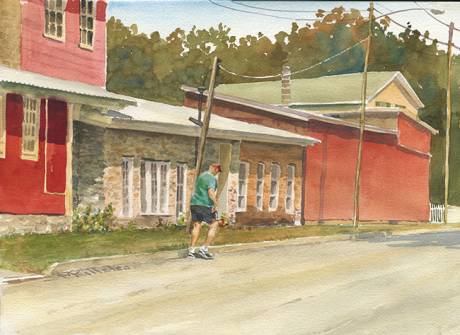
Press release:
Since 2008, Genesee Community College has offered the Genesee Promise Plus (GPP) scholarships to help remove financial barriers to higher education for citizens in the Genesee, Livingston, Orleans and Wyoming (GLOW) counties.
Qualified individuals, from students in high school to adults who have never taken a college course before are encouraged to apply for up to two summer semester courses tuition-free at GCC!
"Summer is a perfect time for new GCC students or students in our Accelerated College Enrollment (ACE) program to jump-start their college coursework," said Lindsay Gerhardt, assistant dean for Recruitment and Admissions. "The GPP program provides a wonderful opportunity for college-bound students to cost effectively earn up to eight transferrable credits.
"Courses can be prerequisites, general education courses or beginner courses in specific fields of study that give students a head start on a degree program."
GPP is available to GLOW region citizens who are high school juniors (rising seniors), graduating high school seniors or new adult college students who have never attended college before.
With more than 100 courses being offered this summer, in two summer sessions both online and at GCC's seven campus locations, there are ample opportunities for all eligible applicants in these categories:
High school juniors (rising seniors) and qualifying homeschool students are eligible for scholarship funding to take one course.
Graduating high school seniors are eligible for scholarship funding to take one or two courses
Adults who have never attended college are eligible for scholarship funding to take one course. This includes adults who have received a GED prior to May 1, 2019 or graduated from a GLOW area high school on or before December 2018. GCC will require a copy of high school transcripts.
GPP scholarship applications are being accepted until June 21 for the 2019 summer session.
The complete list of courses available this summer is available here. The wide array of different subjects includes Basic Math Skills to Statistics and Pre-Calculus, History to Healthy Living, Psychology to Sociology, Business to Biology, and unique courses including Females Roles in Film (CIN242) and Hiking, Walking and Backpacking (PED260), plus many others.
Applications, qualification criteria and additional information are available here.
All interested individuals are encouraged to contact the office of admissions at admissions@genesee.edu or by calling (585) 345-6805 today!
Press release:
Genesee Community College is pleased to announce another exciting annual Spring Job Fair with more than 50 companies expected on Thursday, April 4, from 11:30 a.m. to 1:30 p.m. at the College's centrally located William Stuart Forum.
Genesee's Student Success Center continues to solicit businesses from all types of industries to join the popular, two-hour event that introduces potential new employees to employers, and also provides businesses an opportunity to present their trade and services to the local community.
The event is free to employers and attendees. Employers must register; job seekers are not required to register prior to the event but must sign-in upon arrival.
As of March 19, the following employers are scheduled to be in attendance:
Participating employers include:
For more information, visit: http://www.genesee.edu/career/events/. For a detailed listing of job opportunities by employer, please email a request for the list to career@genesee.edu.
Press release:
The St. Jerome Guild will host the annual “Step into Spring” fashion show, basket raffle, with a luncheon prepared by Michael Tomaszewski, on Sunday, May 5.
The Guild and Genesee Community College will host "Fashion Show Weekend" with Genesee’s annual fashion show, “Limitless” scheduled on Saturday, May 4.
The Guild is excited to highlight several clothing stores in Batavia: JCPenney, Kohl’s, and Marshalls. More than 20 models will feature the Jerome Jewelry Collection and fashions for toddlers, teens, women, men and seniors.
The event will be held at noon at Father Slomba Hall, 19 Sumner St., Batavia.
Presale only tickets are available for $20 at the Jerome Center Gift Shop, 16 Bank St., Batavia. For more information call 585.343.6030, ext. 4198.
The Guild continues to support UMMC/Rochester Regional Healthcare as a corporate donor giving thousands of dollars to capital fundraising initiatives over the years and has contributed countless volunteer hours on a variety of fundraising events.
The proceeds in the amount of $5,000 from last year’s fashion show purchased four natal bassinets.
The Guild has offered an annual Health Career Professional Scholarship to hospital employees and high school seniors for decades. Currently, the scholarship is being awarded to outstanding employees who are continuing their education in the medical field.
The Guild’s volunteerism has served the medical community for more than 100 years. In years past, the Guild sponsored fundraisers for St. Jerome Hospital, such as, casino nights, formal dances, fashion shows, and Mother’s Day breakfasts to name a few.
Press release:
Batavia Downs Gaming & Hotel announced today their plans for a second Kentucky Derby party to be held on Saturday, May 4th. A total of three parties will take place on site.
The party announced today will run from 11:30 a.m. until 7 p.m., will take place in the Batavia Downs Gaming Park Place event center, formerly known as the Paddock Room. This party has seen more than 600 attendees for several years in a row.
New this year is the Superfecta Deal. Patrons will receive their choice of a variety of meals, $15 in Free Play once one point is earned on the gaming floor, a $5 wager on the Derby and program, and a commemorative Kentucky Derby glass, all for just $20.
There will be $5 mint juleps specials, which includes Derby glass and samplings from Black Button Distilling as well as Angry Orchard Rose. Many big screen televisions will show the races and there will be mutuel clerks available to take wagers.
The second annual Derby Gala will take place in the Batavia Downs Gaming Grandstands Banquet Room on the second floor. Tickets went on sale in February at Bataviaconcerts.com and at the Lucky Treasures Gift Shop. Half of the tickets have already been sold.
Admission for the Derby Gala at the Downs is $75 per person and proper attire is required. Patrons will receive an open bar from 4:30 to 7 p.m., grazing stations, a $10 wager on the Derby, $25 in Free Play and a Free Derby program.
The Gala also includes a Best Dressed Contest and Best Hat Contest, which will take place with prizes from the Hotel at Batavia Downs and Four Roses Bourbon.
The third party, taking place inside 34 Rush, will have Woodford Reserve Bourbon sampling along with sampling from Blue Moon. Patrons may place Derby wagers using self-service terminals. The $5 mint julep special will also be available, which includes a Derby commemorative glass.
Wagering will also be available at the second floor Downs Simulcast center. Prize drawings for Derby T-shirts and glasses will take place there beginning at 10 a.m.
The hotel at Batavia Downs is already sold out, but other local hotels do have availability and a shuttle will be running that day to take patrons from those hotels over to Batavia Downs beginning at 3 p.m. instead of the usual 5 p.m.
“We’re looking forward to another great day of parties surrounding our Kentucky Derby events,“ said Todd Haight, general manager of Racing at Batavia Downs Gaming. “The success of the Derby Gala last year adds to the already tremendous day of wagering and entertainment that our guests have come to expect from Batavia Downs.
"Based on the recent Kentucky Derby prep races, this year’s Run for the Roses seems more wide open than ever.”

Above: Byron-Bergen STEAM Jam team with STEAM Lab teacher Craig Schroth. Photo credit: Diane Taylor.
Submitted photos and press release:
On Thursday, March 14, 11 Byron-Bergen fifth-grade students and seven senior high school students in grades 9 through 11 joined hundreds of others from Genesee, Livingston, Orleans, and Wyoming counties at Genesee Community College for STEAM (Science, Technology, Engineering And Math) Jam and Tech Wars.
Tech Wars, now in its 12th year, annually invites students to compete in activities to challenge their innovation, creativity, and resourcefulness.
Byron-Bergen Jr./Sr. High School Technology teacher Jay Wolcott, who has a background in commercial manufacturing, was one of the originators of the competition and annually judges the SUMO bots event.
Other events include CO2 car races, architectural CAD (computer-assisted design), logo design, and the regatta -- during which students ride full-size cardboard boats across the GCC pool.
“Tech Wars encourages students to think outside the box while still maintaining the required parameters,” says Wolcott. “We want something different, cutting edge, but it takes real innovation to solve a challenge in a new way while staying within the limits of size, weight, materials or time.”
The Tech Wars participants vie mostly for trophies and bragging rights but, because of the generous sponsorship from regional businesses, two students also receive scholarships.
“Maybe a student isn’t an athlete,” adds Wolcott, “but at Tech Wars they can compete, use their skills, and be part of a team.”
First-year senior high cchool Technology teacher Meshari Alnouri attended his first Tech Wars this year. Although mostly there to observe and become familiar with the events, his students participated in the High School Mystery Event.
"The Mystery Event was a great experience for my students," says Alnouri. "Between participating and watching therest of the competitions, they’re excited to prepare for next year. I’m excited to help them hone their skills andexpand their vision of what’s possible."
STEAM Jam is a new event with 90 elementary school student participants from eight districts. It is the collaborative project of the regional STEAM teachers’ cohort. Byron-Bergen STEAM Lab teacher Craig Schroth was one of the driving forces behind this year’s event.
“STEAM Jam is a celebration,” says Schroth. “We designed three tasks for the students to complete which encouragethem to get excited about science, technology, engineering, arts, and math.
"It is also a great opportunity for the elementary school students to see the older kids at Tech Wars. We hope that they will carry their enthusiasm withthem to junior and senior high school.”
Fifth-grader Gianna Graff said "I had so much fun at STEAM Jam! One of my favorite parts was being able to seethe older kids compete in Robot Soccer. Now, I am so excited for Tech Wars when I get older."
The STEAM Jam challenges asked students to use design to create a swag item incorporating their school logo and anLED light, construct a tower out of cardboard boxes capable of supporting a toy basketball hoop and surviving a “slam dunk,” and code a robot to launch a ball through a hoop from various positions.
“It was a place where I could use my creativity, engineering skills, and artistic abilities,” said fifth-grade participant Simone Scharvogel. “I can't wait to go back!"
Below: Jay Wolcott and Meshari Alnouri. Photo credit: Gretchen Spittler.
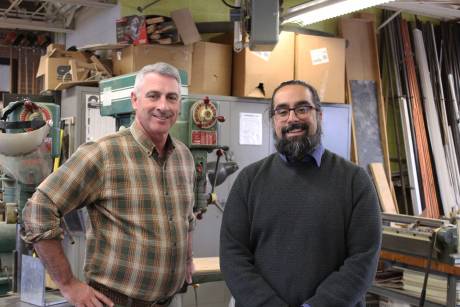
Below: Byron-Bergen STEAM Jam team completing their basketball tower. Photo credit: Diane Taylor.


Bill Farmer cut the ribbon Tuesday, St. Joseph's Day, for the grand reopening of the L.B. Grand Restaurant, two years after he acquired the business and building at 37 Main St., Le Roy.
In the past two years, Farmer has made a lot of changes inside the building (previously: While Farmer's Creekside Inn prospers, Bill Farmer keeps busy in the Village of Le Roy) and Tuesday he said there is still much work planned for the coming year.
In addition to upgrades inside, Farmer is planning to restore the building's facade (he's already put up a new awning).
After the ribbon cutting, guests enjoyed a traditional St. Joseph's Day's meal. Chef Sean Wolf said based on the response this year to the first St. Joseph's Day meal offered by L.B. Grand, next year the staff will plan on laying out a traditional St. Joseph's Day table.
Top photo: Tom Turnbull, president, Chamber of Commerce, Mary Blevins, with the Chamber, Mayor Greg Rogers, Bill Farmer, Chef Sean Wolf, Ethan Olsowski, L.B. Grand staff, and Chamber Board Member Jeff Cook.
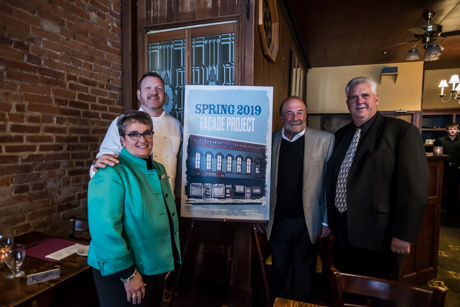
Legislator Shelly Stein, Chef Sean Wolf, Bill Farmer, Mayor Greg Rogers.
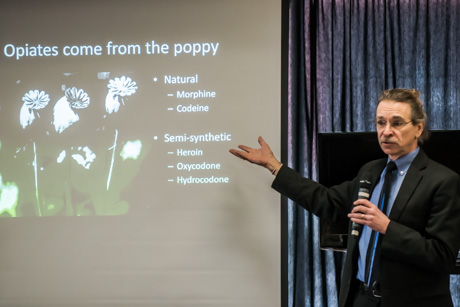
There is a lot of attention paid to opioid addiction treatment, Dr. Richard Blondell told an audience at the City Church Generation Center in Batavia today, but not enough effort is given to preventing addiction in the first place.
"The bottom line of this opioid epidemic is we cannot treat our way out of this epidemic," Blondell said. "We cannot incarcerate out of this epidemic. We can't legislate our way out of this epidemic. What we really have to do is prevention."
Blondell is vice chair of addiction medicine and a professor in the Department of Family Medicine at SUNY Buffalo. He spoke today at a workshop for faith leaders sponsored by the Genesee-Orleans-Wyoming Opioid Task Force.
Drawing on science, history and statistics, Blondell made the case that it's very difficult to successfully treat somebody for opioid addiction; therefore, to end the current epidemic, society needs to produce fewer addicts.
That begins with doctors, he said but includes families and individuals who need to be more aware and better educated about addiction and prevention.
The causes of addiction are both genetic and environmental, Blondell said.
About 10 percent of the population is genetically susceptible to opioid addiction. Those people, when exposed to opioids, usually through prescription medication, are much likely to become addicts.
The addiction for them is a disease.
An addict has about a 5 percent chance of dying in any given year.
"The average life expectancy of a heroin addict is about 10 years, most are gone in 20," Blondell said.
Much of the blame for the opioid epidemic can be placed on Arthur M. Sackler, a medical marketing executive in the 1950s who, among other things, introduced the world to Valium, the first multimillion drug.
"It didn't treat anything actually," Bondell said. "Even though Valium was the number one prescribed drug in the country it was not clear what disease it treated."
The Sackler family went on to own Perdue Pharma, the company that introduced OxyContin.
That pain pill was sold to doctors as non-addictive if used for pain.
Then the insurance companies got involved, Blondell said. They stopped funding pain-management regimes, which could cost thousands of dollars but were effective, in favor of prescription pain medications. And if doctors didn't prescribe enough pain pills, they would get low patient satisfaction scores from patients who said, "he didn't do anything for my pain."
Doctors started prescribing opioid-based pain medications "like skittles," Blondell said.
Patients who become addicted to pain pills often, usually, turn to heroin, which is cheaper and easier to get. About 75 percent of heroin addicts started with a prescription to either the addict himself or to a friend or family member.
There are two types of treatment for addicts, neither high success rates -- counseling or medication.
In counseling, an addict receives psychological therapy, or they might live in a home and where they can learn adult life skills but if they are physically addicted, brain condition related to addiction is not treated. That is where medication, such as methadone, come in.
Blondell said all treatment methods should continue but that isn't the final answer on the epidemic. We've never treated our way out of an epidemic, he said.
People who say addiction is a choice really don't understand opioid addiction, Blondell said.
Everybody is addicted to something. Addiction is essential to survival. We're all addicted, for example, to water.
But what substances, such as illicit drugs and alcohol do, is trick the brain into thinking that substance is a higher priority than other addictions, such as food.
"So people say to me, this is a behavior," Blondell said. "It's not really a mental illness or it's not a disease. It's not a disorder. It's really just a behavioral problem. To which my question is, what organ in the body produces behavior? Is it the kidneys? Is it the liver? No, it's the brain. So it's the brain that produces the behavior that we see and pass judgment on."
If we're going to end the epidemic, Blondell said, doctors need to be more cautious and judicious in when and how they prescribe pain medications. Patients who receive them need to be better educated about taking the prescribed amount for only a short period of time. Parents need to ensure they control the distribution of pain medication to their teen children, and ensure they actually take them when dispensed so they're not hoarded so five or six can be taken at a time. Everybody needs to be better educated about the nature of addiction and how to avoid it.
From the GC Health Department:
According to the 2019 County Health Rankings, released today by the Robert Wood Johnson Foundation (RWJF) and the University of Wisconsin Population Health Institute (UWPHI) the Genesee and Orleans counties rank 42nd and 52nd, respectively, in overall Health Outcomes.
The Rankings are available at www.countyhealthrankings.org.
“As chief health strategists, we use the County Health Rankings to help us identify factors that are important for residents to live long and healthy lives and understand how we compare to other counties in the state," said Paul Pettit, director of the Genesee and Orleans County Health Departments.
"With this knowledge, we can take steps to improve the health of our residents. The county with the lowest score (best health) gets a rank of #1 for that state and the county with the highest score (worst health) is assigned a rank corresponding to the number of total counties ranked in each state. New York State has 62 counties.”
The rankings are broken into to two main categories, Health Outcomes, which include length of life and quality of life, and Health Factors, which include health behaviors, clinical care, social and economic factors and physical environment. Genesee County ranked 42 out of 62 counties for Health Outcomes and 29 in Health Factors. Orleans County ranked 52 in Health Outcomes and 54 in Health Factors.
“The County Health Rankings show us that where people live plays a key role in how long and how well they live,” Pettit said. “The Rankings allow local leaders to clearly see and prioritize the challenges they face — whether it’s rising premature death rates or the growing drug overdose epidemic — so they can bring community leaders and residents together to find solutions.”
According to the 2019 Rankings, the five healthiest counties in New York State (NYS) starting with most healthy are Rockland, followed by Nassau, Westchester, Saratoga, and New York. The five counties in the poorest health, starting with least healthy are Bronx, Sullivan, Cattaraugus, Chautauqua and Niagara.
What’s new for 2019? This year’s Rankings explore severe housing cost burden and health. The 2019 Key Findings Report highlights the link between housing and health that the RWJF and the UWPHI are seeing across the nation. As housing costs have outpaced local incomes, many families not only struggle to acquire and maintain adequate shelter, but also face difficult trade-offs in meeting other basic needs.
Did you know that across counties increases in the share of households that are severely housing-cost burdened are linked to more children in poverty and more people facing food insecurity?
New measures this year that help to illustrate how counties are fairing including Severe Housing-cost Burden, Homeownership, and Life Expectancy. A new ranked measure included this year is Flu Vaccinations. In addition, an updated data source for the ranked measures of Preventable Hospital Stays and Mammography Screening are being used.
“The County Health Rankings show how Genesee and Orleans Counties rank on factors that influence its overall health ranking,” Pettit said.
For example, Genesee County has an improved Clinical Care ranking, scoring 40 this year as compared to 57 out of 62 counties five years ago. This improvement can be attributed to a lower uninsured population (under age 65) than the NYS average, as well as an increasing number of mental health providers available although still far behind the state average.
A similar trend can be found in Orleans County in regards to these two ranked measures. Additional strengths in Genesee County include a lower percentage of
children living in poverty, which is 15 percent as compared to the state average of 20 percent. As well, the high school graduation rate in Genesee County (91 percent) and Orleans County (89 percent) in 2019 is higher than the state average of 82 percent.
The rankings of Social Associations, Severe Housing Problems, and Long Commute-Driving Alone are also fairing well in both counties compared to the NYS averages. Orleans County has also improved in the Physical Environment and Health Factors rankings, by 11 points (21 out of 62) and two points (54 out of 62) compared to 2018.
Even with the above mentioned positive trends, both counties continue to have challenge areas and are still struggling with health factors specifically with adult smoking (Genesee – 20 percent / Orleans – 22 percent), adult obesity (Genesee – 35 percent / Orleans – 36 percent), physical inactivity (Genesee – 29 percent / Orleans – 31 percent), access to exercise opportunities (Genesee – 61 percent / Orleans – 70 percent), driving alone to work (Genesee – 84 percent / Orleans – 80 percent), and access to clinical care for primary care physicians, dentists and mental health providers.
Orleans County is also ranked as having a higher percentage of children living in poverty (24 percent) as compared to the state average mentioned earlier.
The Rankings have become an important tool for communities that want to improve health for all. Working collaboratively with community partners, Genesee and Orleans counties have a number of initiatives to expand health opportunities for residents, including providing the National Diabetes Prevention Program (Prevent T2), a lifestyle change program to prevent or delay Type 2 diabetes; the Get Fit! Program, an eight-week family-friendly physical activity and nutrition focused program; a tri-county Opioid Task Force; decrease smoking/nicotine usage through referrals and increase cancer screenings.
“The Rankings data will be used in conjunction with additional local sources, such as the Community Health Assessment (CHA) Surveys and Community Conversations that are being collected and occurring now, to inform the 2019-2024 Genesee, Orleans and Wyoming (GOW) Community Health Improvement Plan (CHIP) which will be submitted to the NYS Department of Health this December, Pettit said.
The CHA survey is available online in English and Spanish until March 31, 2019. Paper copies are also available at various locations in each county. The survey is anonymous and only takes about 15 minutes to complete and focuses on the health of the person taking it. If you are younger than 18, be sure to receive permission to take the survey from your parent(s) or guardian(s).
To access the GOW CHA survey visit here for English or here for Spanish.
The GOW Health Departments are also seeking to schedule Community Conversations with willing groups to learn what they feel are the greatest health concerns or issues in their community and thoughts on how they can be improved. Responses from the confidential surveys and conversations will help identify services that are working, need improving, or to be created.
The more members of the public who participate, the larger and stronger the “building block” of these plans will be!
To participate in a community conversation, obtain hard copies of the survey, or have any questions about the County Health Rankings, please contact your local health department.
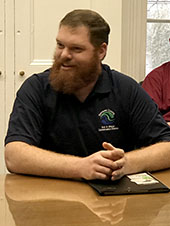
The job of Soil and Water Conservative, District Manager Brad Mudrzynski, told the Public Service Committee on Monday during a department review, is pretty straightforward at its most basic: Keep soil healthy; keep it on dry land; keep it out of water, so water is kept clean.
Mudrzynski became the director in January, the second since George Squires retired a couple of years ago after 31 years of service to the county, but Mudrzynski, who is from Elba, said the district has continued to operate without missing a beat.
Genesee County's soil and water district was established in 1944. Every county in the state has a soil and water district. The county budgets about $150,000 annually to fund the district. That pays for personnel, currently four full-time staffers and one part-time employee, and it's up to the district to apply for grants and aid to fund its programs.
"We have a good core," Mudrzynski said. "I hope I get to keep my core because they are really good people. They all know what they're doing."
The current staff is Molly Cassatt, a technician (the former director who volunteered to change rolls), Bob Berkemeier, senior technician, Tim Welch, technician, and Laura Bestehorn, clerk-treasuer.
In Genesee County, most programs are focused on agriculture but the agency also works with municipalities. For example, soil and water is using a $6,000 state grant to fund a hydroseeding program with the towns.
Hydroseeding, rather than just spreading grass seed on the ground, helps prevent runoff and soil erosion.
Other programs and services include tree and shrub planting, fish stocking, an Envirothon, recycling events, permit assistance, guidance for invasive species control, and erosion control design.
In 2018, the district secured nine grants worth $1.2 million.
Mudrzynski said soil and water districts are unique in the state because they operate as quasi-state agencies but with local control, which makes them more nimble and responsive to local needs.
There are 95 bridges and 256 culverts in the county's infrastructure inventory and combined they're worth about $70 million, County Highway Superintendent Tim Hens told members of the Public Service Committee on Monday.
That's a conservative estimate, Hens said.
He arrived at the number based on the amount spent on bridge and culvert replacement over the past three years without adjusting for inflation.
Genesee County is one of three counties in the state that are economically responsible for all bridges and culverts on non-state roads, including those in towns and villages. In every other county, towns and villages must maintain and replace old bridges.
It's been that way since 1939 when the board of supervisors passed legislation giving county control of bridges and culverts.
A bridge (defined as more than 20 feet long) can be expected to have a safe, useful life of 50 years. The average bridge in the county was constructed in 1968, Hens said.
To keep up with the replacement cycle of bridges, the county needs to replace two bridges a year but in recent years, with cuts in federal aid, the county has only been able to replace one bridge a year.
Typically, state and federal aid helps pay for bridge and culvert replacement but as that aid is cut back, the county may need to turn to other sources of local revenue, such as sales tax.

A proposed local law aimed at curbing property thefts is back before the County Legislature after undergoing revisions to more narrowly focus its intent on pawn shops and other businesses most commonly favored by criminals to fence stolen goods.
County Attorney Kevin Earl worked with a variety of interested parties, including District Attorney Lawrence Friedman and Chief Deputy Jerome Brewster to draft proposed language that would still meet the intent of the legislation, but ensure it only hit its target without potentially adding an unintended regulatory burden to other local businesses.
The original bill was introduced in November and met some initial opposition from some members of the Legislature and some local business owners.
The key change of the law narrows the scope of the regulations to businesses known as "pervasively regulated." Prior case law has established that certain business activities can be monitored by the government without a warrant because of the nature of the business. In New York, these already include pawn shops, coin dealers, chop shops, and other enterprises that can be used as fronts for stolen property.
The change ensures the law can't be used to impose regulations on commercial thrift-type stores, used book and record stores, antique stores, or businesses that resell gift cards, among other establishments that might have been swept up in the prior broader language of the law.
Public Services Committee Chair Shelly Stein said during yesterday's committee meeting that it's important to remember the purpose of the law.
"We are trying to assist victims of theft and robbery in the county," Stein said.
Even so, the revised bill isn't supported by all members of the Legislature. Both legislators John Deleo and Andrew Young said they are uncomfortable adding another layer of regulation on private enterprise.
"We have one pawn shop here and we're creating more mandated laws when we get upset when the state puts mandates on us," Deleo said. "I don't think it's right. I have faith in law enforcement that if we have a problem, we can solve it. I don't care how much lipstick we put on this, I have a hard time buying into it. I guess I have more faith in law enforcement.
After the meeting, Young said he still isn't satisfied with the language of the law.
"It has been suggested that the decision to be made to pass this law is easy because it is simply to choose between victims of stolen goods and potential criminals," Young said. "I don’t agree that is what it is about. The decision to be made is to weigh the cost of additional government rules, regulations and reporting requirements against the value those government-imposed burdens provide towards assisting victims of theft.
"The changes made make this law better and somewhat less intrusive. I am not sure we have reached the point where the value of this law outweighs the cost."
Another significant change is the elimination of the licensing fee for a qualified secondhand dealer.
"We did this to address the suggestion that this was only a money grab by the county," said County Clerk Michael Cianfrini. "We wanted to eliminate that concern."
Earl said he's confident that changes in the bill's language will help it withstand any potential Constitutional challenge.
Niagara County passed a new law similar in language to the original draft of Genesee County's law and Earl said officials up there, after he shared his concerns with them about the local law, don't intend to make changes.
"Niagara County had nobody show up at their public hearing," Earl said. "There were no objections. It's probably a good thing we had objections up front or we might have had problems on the back end."
Brewster said just discussion of the law has compelled Pawn King on Veterans Memorial Drive, Batavia, to start using Leads Online, a digital service used by pawn shops to enter items received into a searchable database. Law enforcement agencies can then subscribe to the service (there's no cost to the merchants who participate) so they can see what items are coming into the shop and check the list of items reported stolen.
Pawn King was already using the service in other counties where it does business because those counties legally compel Pawn King to use Leads Online.
Brewster said passage of a similar law locally will ensure Pawn King continues to use the service and will help ensure their compliance is thorough.
Businesses required to record transactions and hold items for at least 10 days under the law could lose their license and be forced to close if found out of compliance.
Mike Barrett, owner of Barrett Marine, said after the meeting that with the revisions, he's more comfortable that the new law. If passed, it won't apply to Barrett's business, but the owner of John G. Cooper Coin Shop in Le Roy said at age 76, this law may be a signal that it's time to retire.
Previously:
Press release:
Imagination Station Child Care & Preschool is expanding its operation and adding a new location in Batavia. Known as the “Batavia East Center,” the location is scheduled to open mid-May and is located at 5079 Clinton Street Road in Batavia, the former Grandma’s Lovin’ Care building.
The center will have a variety of new features for Imagination Station and upgrades from its current location in Batavia. The building will have cameras in every classroom, a private playground, and doors throughout which lead to the outside, and a brand-new school-age classroom in the lower half of the building, which will be over 1,000 square feet!
Imagination Station is upgrading the building to include painting throughout, all new window treatments, new flooring in needed areas, an improved parking lot, and all new equipment and furniture in the classrooms.
“It’s a beautiful building and we’re excited for children to be occupying it again!" said owner Kelly Kronbeck. "We’re giving the building some love and attention, then we’ll be ready to open in the spring.
"We look forward to being able to create a more intimate environment at each of our Batavia locations since overall they’ll both be smaller in size."
Imagination Station, which is a locally owned and operated child-care provider, currently has a total of five centers, including the newest Batavia addition.
The new and improved center on Clinton Street Road will accommodate children from the ages of 6 weeks to 12 years old and has capacity for 112 students. The center will consist of two infant classrooms, three toddler classrooms, two preschool classrooms, and one school-age classroom.
Imagination Station prides itself in offering an educationally based program that is safe for its students and professionally run for its families. They credit their success to the hands-on approach they take in running their centers, but also by offering a high-quality program at an affordable rate, which is about 20 percent lower than its competitors between Buffalo and Rochester.
Interested families can tour the existing location by setting up an appointment! Enrollment is now available for both locations and is being filled on a first-come, first-served basis. Please call 585-343-0990 or visit the company’s website at www.istationccp.com for more information.
Copyright © 2008-2022 The Batavian. All Rights Reserved. Privacy Policy | Terms of Service